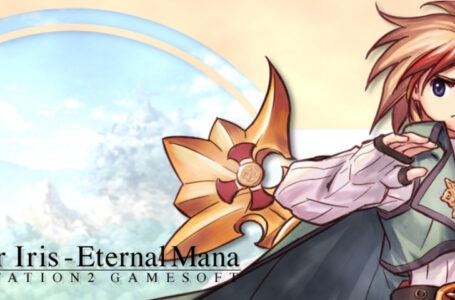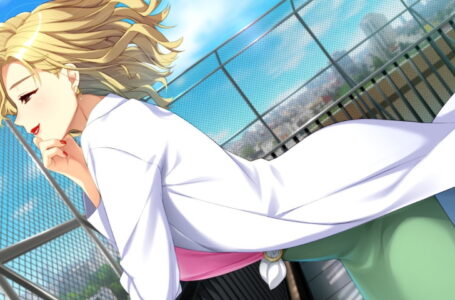Exploration and questing in the world of Atelier Sophie 2
So far, we’ve taken a look at how Atelier Sophie 2: The Alchemist of the Mysterious Dream builds on its narrative predecessor and how it fits into the grander context of the Atelier series as a whole, how it adapts and expands on the alchemy mechanics seen elsewhere in the Mysterious series, and how it presents its battle sequences. Next on the agenda is a peek at the overall game structure: what do you actually do in a typical session with Atelier Sophie 2?
One of the great things about the first Atelier Sophie game is that although it had a narrative to follow through to an eventual conclusion, for much of its runtime your final goal was left rather vague, meaning that the game as a whole had a rather pleasingly freeform feel. Yes, there were usually objectives you could pursue that would advance the main plot, but outside of that you were relatively free to explore the game as you saw fit.
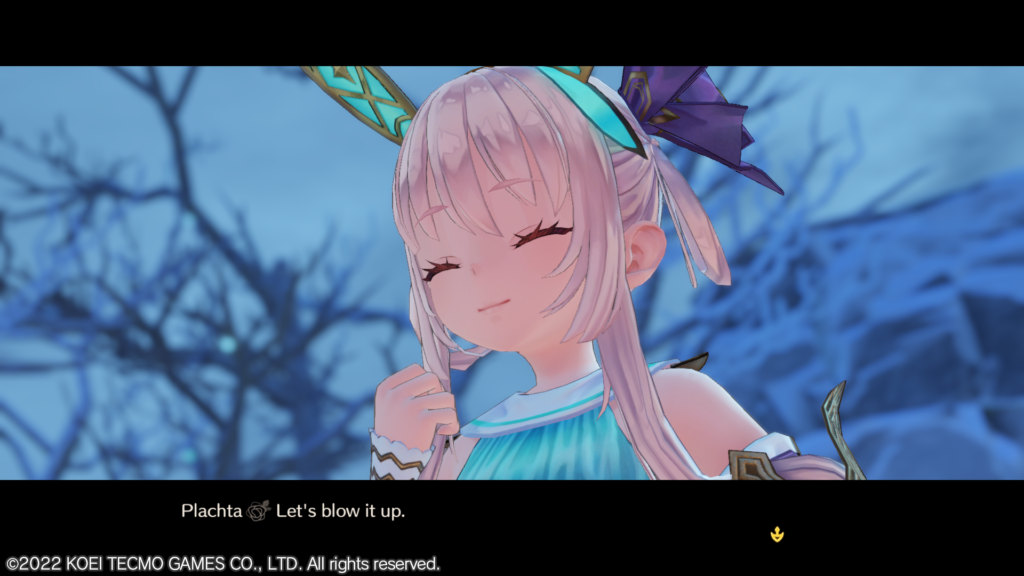
In this respect, Atelier Sophie actually felt like it had a lot more in common with older computer role-playing games than the strictly linear structure we’ve come to associate with console-style RPGs over the years. This feeling was continued with the open-world Atelier Firis, which provided even more freedom to explore the world in between major story beats — and indeed, in that game, after you finished the one major objective, you could pretty much bring the game to a conclusion at any point you desired simply by tugging at a single narrative thread until you found the end of it.
Atelier Sophie 2 feels like it follows this tradition… to a certain extent, at least. The game always makes your next major objective completely clear — but it’s pretty rare that you are forced down that path, and more often than not you’ll find that successfully following that critical path generally requires you to head off and do some other things anyway. This is particularly the case when progression is dependent on you crafting a specific recipe that you don’t yet know, or which you don’t yet have the ingredients for.
Atelier Sophie 2 does keep one thing in common with its predecessor, though: for a significant proportion of time, it’s not entirely clear what your end goal might be. This is mostly a function of the narrative, which we’ll talk more about when we explore it in greater detail, but it also helps the game feel less restrictive.
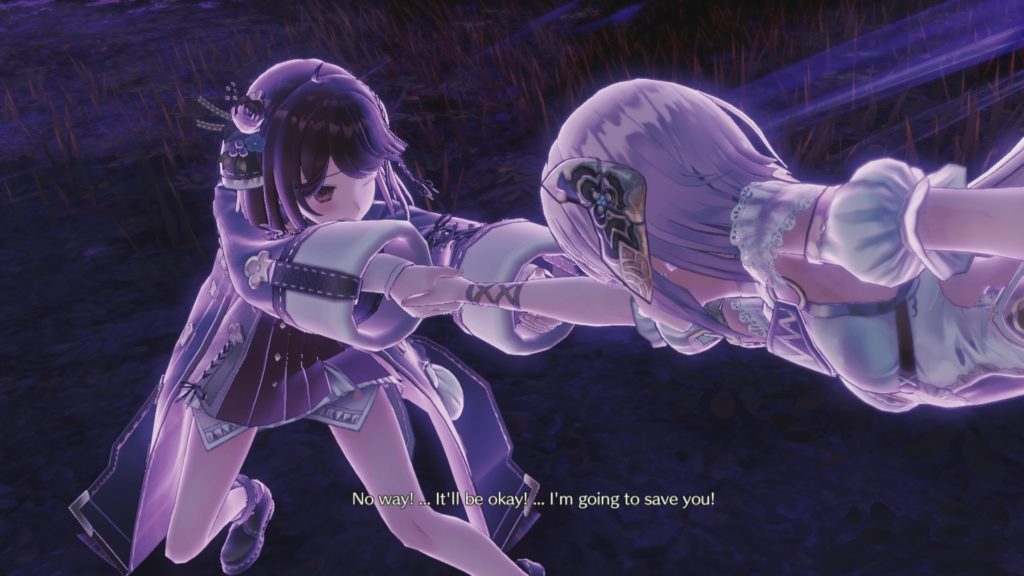
At the outset of the game, Sophie and her companion Plachta are drawn into the mysterious dream world of Erde Wiege, but Plachta goes missing. Ostensibly, your objective is then to track down Plachta — and it’s not really a spoiler to say that this eventually happens, given that Plachta herself is plastered all over the game’s key art — but after that… what? It’s initially hard to say — particularly given that Sophie hasn’t come to Erde Wiege for the same reason as other people.
Erde Wiege is quite literally a land of dreams, you see. Its goddess Elvira takes an interest in people who have a dream that they would like to achieve, and allows them the opportunity to realise that dream in Erde Wiege. Just to make the prospect of this extra-appealing, no-one ages while they are in Erde Wiege, and when they return to the real world they will find that no time has passed. In this way, they can accumulate a lifetime (or more’s) worth of experience in Erde Wiege, then, when they feel good and ready, return to the real world.
Does Sophie have a dream that she wants to achieve, though? Well, kind of; firstly, she wants to take the national alchemy license exam and become an officially certified alchemist, but she doesn’t accomplish this until Atelier Firis. Secondly, she wants to find a way to help Plachta transfer her soul from the doll body she currently inhabits into an actual living human body. Again, when Atelier Firis rolls around, we’re given no indication that she has successfully accomplished this, and it’s pretty clear from the first time Sophie mentions this that she knows it’s not something that is going to be achieved overnight.
With that in mind, while Sophie has things that she potentially could achieve in Erde Wiege, for the most part she’s just sort of… there. Initially, it might feel like she’s trapped there against her will, but speaking to others around Atelier Sophie 2’s central town reveals that anyone in Erde Wiege is free to leave whenever they wish — they simply have to either achieve or give up on their dream.
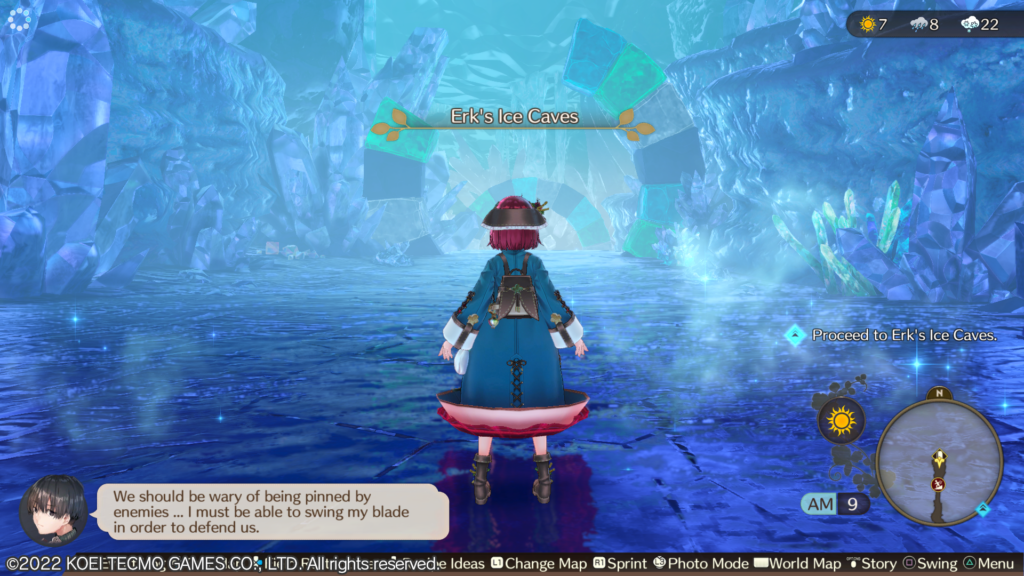
Thus, part of Sophie’s interest in staying in Erde Wiege for a while comes from her curiosity about the people around her, and what it is they want to achieve. Particularly since two of those people are very important to her: a younger incarnation of Plachta, and her grandmother as a twentysomething unmarried woman.
All that’s getting into narrative territory though — what we’re really concerned with today is what all this means in practical terms for Sophie and the companions she gathers during her time in Erde Wiege.
Well, that hybrid between “freeform” and “linear” is a key part of how Atelier Sophie 2 works. Generally speaking, progressing through the main story unlocks new areas for Sophie and company to explore, and once they are unlocked, Sophie is free to spend as much time as she wants taking full advantage of those new areas for questing, gathering, fighting and making new alchemy items.
The areas themselves occupy a space somewhere between the original Atelier Sophie’s fairly constrained field areas and Atelier Firis’ sprawling open fields. They’re large enough to feel like it’s worthwhile exploring them, but generally speaking there aren’t too many different paths you need to wander down.
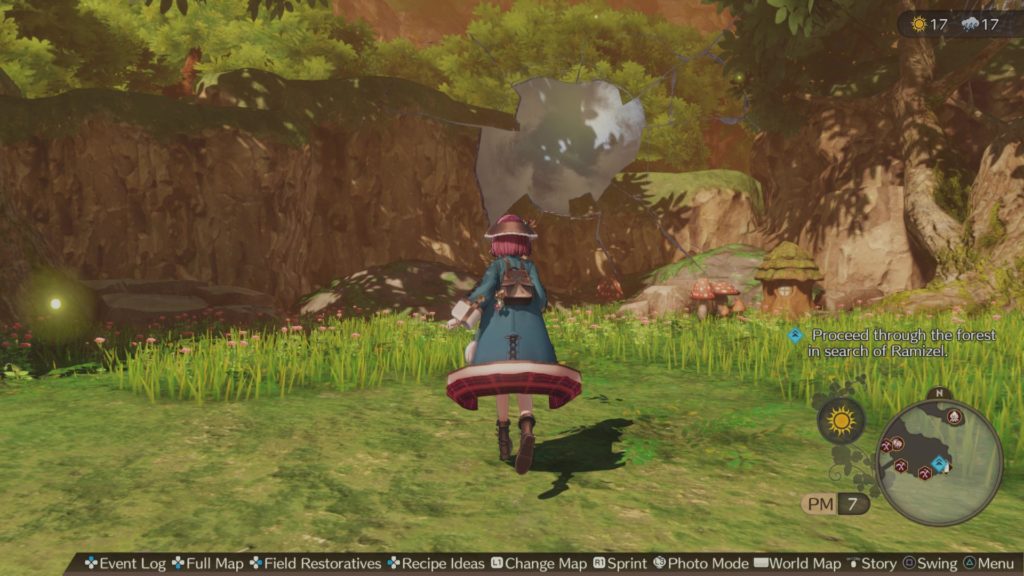
A particularly interesting aspect of Atelier Sophie 2 is the fact that initially, you can’t necessarily get everywhere, even in the starting areas. As the main narrative progresses, Sophie will unlock various tools that allow her to interact with scenery items, with some of the most important being the weather manipulation gems.
Scattered around many of the zones are plinths of various colours that allow Sophie to change the weather with an appropriate item. When you first unlock this ability, you’re able to swap between sun and rain, but as the game continues additional options become available — though only where the relevant plinths exist.
Manipulating the weather in Atelier Sophie 2 allows you to open up and close off paths around the place — bringing the sun out, for example, generally causes the water level to drop, allowing access to areas that were previously flooded. Making it rain, meanwhile, will raise the water level once again — and this sometimes allows access to new areas via platforms made of materials that float. When snow gets added to the mix, manipulating the water level and then freezing it also becomes an important part of getting around — and the deeper you go into the game, the more options you have.
Exploring areas fully is not just important for progressing through Atelier Sophie 2’s story — you can also find special areas known as Landmarks in most maps. These are areas of noteworthy scenery that are simply fun to find, but there’s a greater benefit to them too: each one you discover provides at least one character in the party with Ability Points that they can use to unlock passive skills or upgrade their existing active skills. Thus they become an important part of the game’s overall progression system — but by no means something you need to rely on exclusively, as we’ll talk about in a moment.
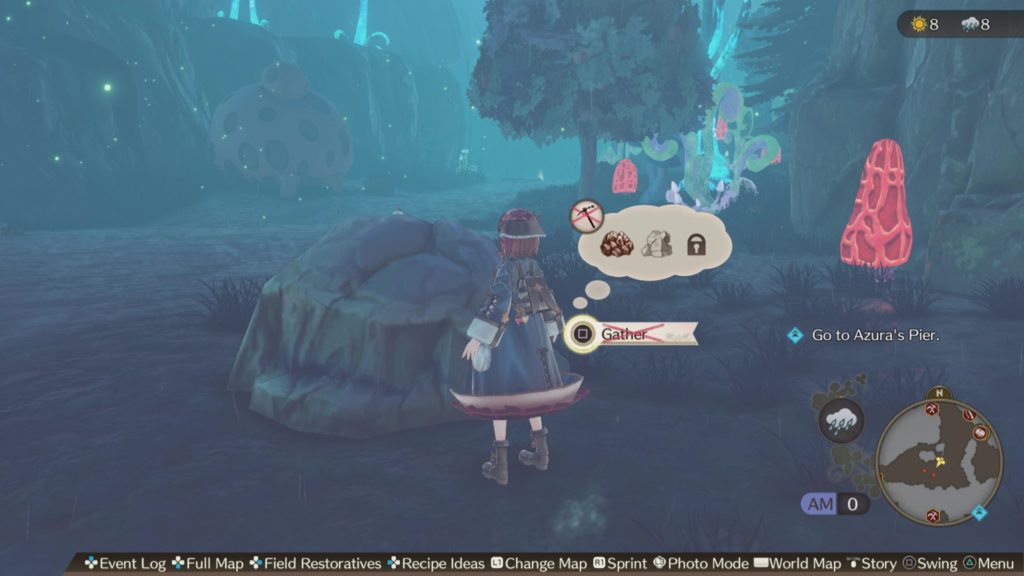
While exploring, Sophie will encounter numerous gathering points. You can generally figure out what kind of item you’re likely to get from a gathering point from its appearance; a log will give you wood, a pile of little rocks will get you sand, a big rock will net you ore and perhaps gemstones. Standing next to a gathering point will cause a thought bubble to appear above Sophie’s head, indicating what the gathering point will yield without requiring you to collect it and clutter up your inventory. And as you level Sophie up and acquire new abilities, the various gathering points will yield higher “tiers” of items, providing a greater variety of collectible ingredients.
To go along with this, certain gathering points require specific tools to take advantage of them. Fruit and plants hanging high on cliffs or in trees require a slingshot, for example, while heavy rocks require a pickaxe and giant crystals need a “Bomb Hammer”. You don’t just get handed these items; you need to craft them as Sophie. And, as with pretty much everything else in the game, the better you take advantage of the alchemy system while making your tools, the better results they will yield.
For the most part, the tools are just used to get ingredients, but there are a few instances in which they gate overall progression through Atelier Sophie 2. For example, in one sequence, Sophie is unable to proceed forwards without the Bomb Hammer because there’s a giant crystal blocking her path. At various other times, you may find yourself needing ingredients that can only be acquired with the tools — so it’s better to try and craft them sooner rather than later.
And having access to a wider variety of ingredients also means you’re better positioned to be able to complete quests and obtain rewards. This is where Atelier Sophie 2 feels at its most freeform, because alongside the main scenario quest, at any given time you generally have a number of different options for what you can take on.
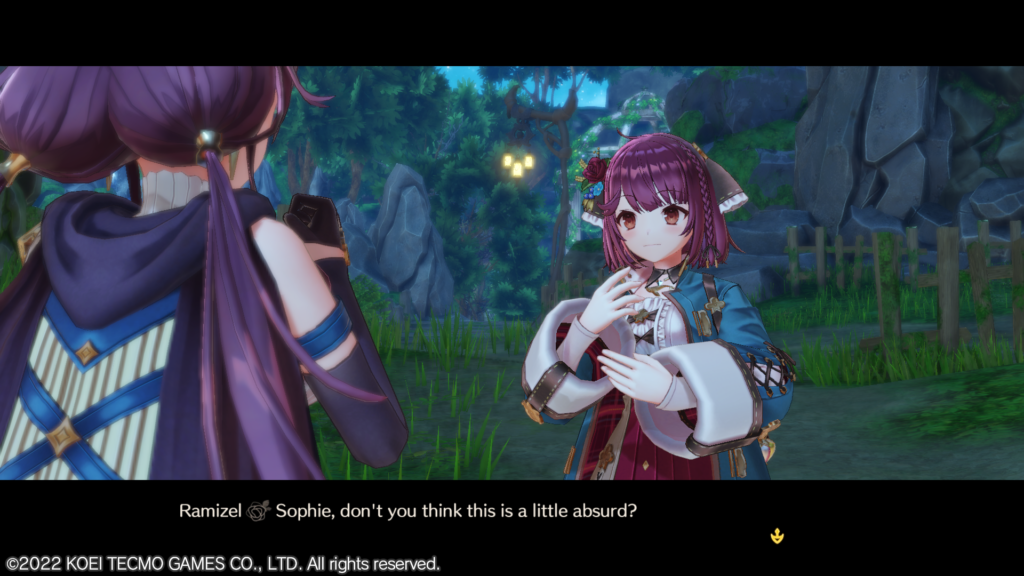
Character stories crop up at semi-regular intervals, and provide opportunities to get to know the main cast. Sometimes these are simple conversation scenes, while others they will have an actual “quest” component that requires you to accomplish something. In most (though not all) cases, picking up these events when they appear will cause the characters’ friendship level with Sophie to rise, which unlocks new ways of them assisting her during alchemy as well as, a little later in the game, double-team special attacks.
Town quests, meanwhile, are the same bits of day-to-day work we’ve been doing in Atelier games since Atelier Iris 3: Grand Phantasm. Sometimes these require you to craft something, sometimes they require you to gather something, sometimes they need you to kill something. Pleasingly, they’re always given a little nugget of narrative context through a note attached to them, and there are several distinct questlines that progress over time rather than simply being recurring, repeatable tasks.
Town quests are important to take on because they’re a reliable source of income for Sophie. And money is important — not necessarily for buying things (though it is often more convenient to buy certain ingredients from vendors than gathering them yourself) but for making use of the item duplication and restock facilities provided by the game. The former is self explanatory: pay a fee and get one or more exact copies of an item; the latter is the ability to automatically replenish the “charges” of all the consumable items you take into the field with you upon returning to Sophie’s workshop.
As you might expect, adventuring can get expensive if you don’t budget accordingly, and thus keeping up with town quests is an important part of the Atelier Sophie 2 experience. The nice thing about them is that you can generally take them on while doing other things, but it can also be a satisfying play session in itself to simply load up on quests and systematically check them off one by one — particularly the ones that involve hunting powerful enemies or seeking out rare items.
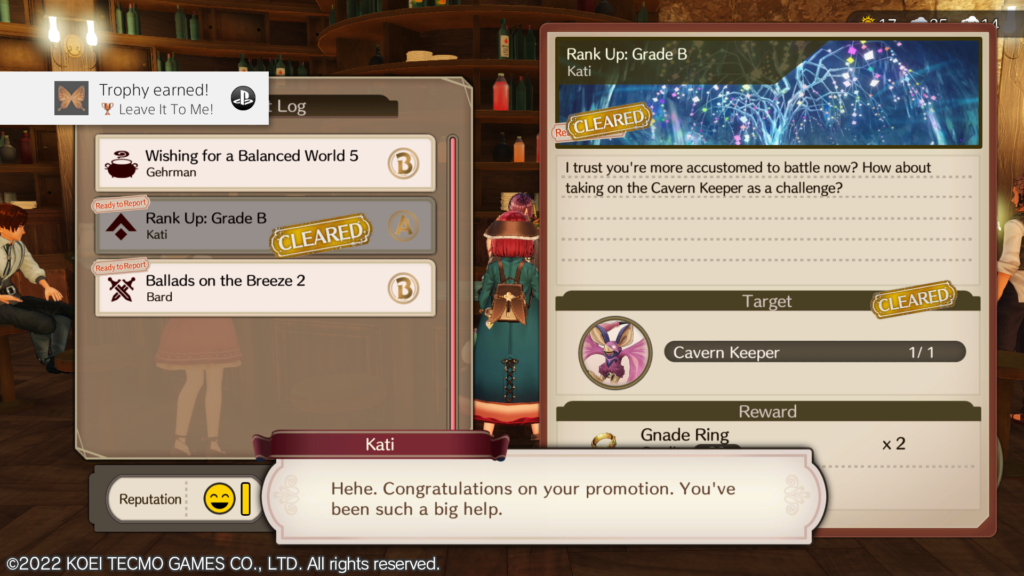
There’s a third type of quest that is distinct to Atelier Sophie 2, though: Party Quests. These are absolutely core to the character progression system in that they offer the most significant Ability Point rewards. And these are absolutely intended to be completed alongside other things that you’re doing, since they are generally things like “make [x] food items” or “use [y] ability in combat [z] times”. In other words, they’re strongly mechanics-focused rather than having narrative context — but they provide one of the most reliable means of beefing up your characters beyond simply levelling them up.
Between all these different systems, you can hopefully see that Atelier Sophie 2 is far from being a straightforward, linear RPG. I mean, given the nature of the way the main scenario is delivered a “quest” at a time, you probably simply could just follow the critical path through to the end of the game and be done as quickly as possible — but if you do that, you’re sort of missing the point of the game as a whole.
The strength of Atelier Sophie 2 — and indeed of the Atelier series as a whole — is giving you a small-scale but beautifully detailed world to explore, get to know and really “live” in. And Erde Wiege certainly provides plenty of things to do while you’re taking a holiday there!
Atelier Sophie 2 is out now for Nintendo Switch, PlayStation 4 and PC.
Join The Discussion
Rice Digital Discord
Rice Digital Twitter
Rice Digital Facebook
Or write us a letter for the Rice Digital Friday Letters Page by clicking here!
Disclosure: Some links in this article may be affiliate links, which means we may earn a small commission if you make a purchase after clicking on them. This is at no additional cost to you and helps support Rice Digital!
- Letter from the Editor: passing the torch - June 30, 2023
- Super Woden GP 2 is looking promising - June 30, 2023
- Inti Creates is making a 32 bit-style Love Live action platformer - June 26, 2023






